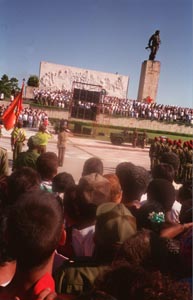
Che Guevara's coffin lies behind a Jeep. Fidel is in the reviewing stand beneath a statue of Che.
Photo by Dan Pulcrano
On the road with Che Guevara
By Dan Pulcrano
About a third of the way from Holguin to Santiago de Cuba, the four of us knew we should have taken the other road. A heated argument among my backseat drivers had prompted us to reverse our course from the paved but less direct route through Bayamo. Now, the mud-splattered four-door was deep into the "shortcut" that was going to shave many kilometers off our trip: a slippery, unlit parade of puddles and potholes through endless fields of sugar cane, crossed only by birds, stray dogs and railroad tracks.
Nary a sign marked the way, even when the road forked. Halfway through the four-hour final stretch to Santiago, the first sign of human life bounced our way, and we waved and flashed the oncoming headlights to a stop. But the drunk taxi driver hadn't a clue about whether this was the route to the country's second-largest city. Behind the taxi was another car, a Russian-built Lada, from which we could attempt to coax directions, but by the time the second of the six occupants began to exit the vehicle, Jimo was backhanding my knee and cueing me in English, "Let's go, let's go." Cuba's one of the safest countries in the hemisphere, a lot less violent than the U.S., but nobody wants to test that theory in a car with tourist plates on the agricultural backroads of a nation where nearly everyone takes home less than $10 a month.
We finally reached our destination in the wee hours, and as we got ready to set out the following afternoon, Turi and his American girlfriend, Steph ("My revolutionary response to an imperialist policy"), elected to spend more time in Santiago and take in the sights. That was fine with Jimo and me, not only because we would save time with fewer people asking for pit stops and offering navigational advice, but because we could smoke cigars all the way to Santa Clara, where the famous Latin revolutionary Che Guevara would be buried the next morning, on October 17.
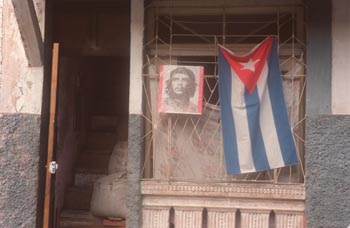
Dan Pulcrano
Santa Clarans hung flags and Che photos throughout the city.
Fear and Loathing in Las Tunas
We left Santiago a little before 5pm for the 12-hour drive. To consider making a 1,200-mile round trip through the Eastern provinces of Cuba in 3 1/2 days, a person would have to be insane. Jimo and I felt we qualified.
According to a road atlas published last year, on the carretera principal that connects east and west Cuba, "the majority of the crossways are produced strinking (sic) with other roads, so that cautions must be carry to an extreme. All these roads, specially the Carretera Central, resist a very intensive traffic with many obstructions." The guide is generous. We dodge lakes of water, as well as bicycles and horse carts; banana flatbeds; black, smoke-belching Soviet trucks; social circles on the asphalt; and longhorn steer that wandered onto the roadways. While slow-moving, the cows were the least problematic because they were white and easy to spot at a distance, unlike the bicycles or trucks, which couldn't bother with rear reflectors or lights.
When we stopped for coffee at a roadside stand near Las Tunas, a guajiro approached and offered to sell a leather knife sheath for a dollar. What did I need a sheath for when I didn't even have a cuchillo, I asked him. But Jimo, seizing the moment and remembering our encounter the night before on the dirt road, somehow managed to talk the chef out of four cups of Cuban coffee and his chef's knife, and the peasant out of his sheath, all for a single greenback. We hopped back in the Mitsubishi, and an unarmed private in fatigues (who was probably 18 but looked a lot younger) opened the passenger door and confronted Jimo, arguing that foreigners couldn't carry knives in Cuba. Jimo, incredulous at the accusation, shouted, "I'm more Cuban than you!" and slammed the door. As we barreled laughing into the night, passing trucks and bicycles and horse carts, Jimo clipped two fresh cigars and took a long swig from the bottle of Guayabita del Pinar, a dry tropical fruit brandy from the other end of the island. There are no laws against open containers in Cuba--or for that matter smog checks or seat-belt regulations or enforced speed limits. And you can smoke cigars in restaurants.
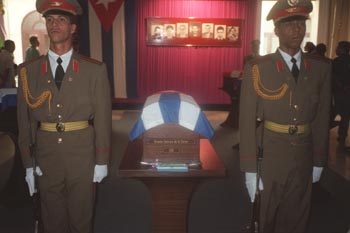
Dan Pulcrano
A coffin containing Che's bones lies in state in Santa Clara on Wednesday, October 15.
Beat Fictions
Admittedly, this was the grit I craved during a week away from the office. I was worried at first, though. The night we left Havana, Jimo pulled out a cassette of what he represented as great rock, and suddenly the Bee Gees were singing "Cherish the Love," followed by Christopher Cross and Foreigner. I quickly pulled off at the first Servicentro, a fluorescent-drenched bank of pumps that sells rum, canned meats and Che Guevara T-shirts. Of the dozen or so $5 cassettes under the glass counter, I picked the best driving music I could find, a copy of Queen's greatest hits.
I had been fantasizing about a trip that would be a modern-day equivalent of On the Road, with me as Dean Moriarty driving a mud-spatttered '49 Hudson through the Kansas plains, Mary Lou and Ed Dunkle in the back seat. Musically, at least, it was turning out to be closer to Wayne's World, with Garth Algar cruising to Stan Makita's donuts in his AMC Pacer Mirthmobile while lip-synching Bohemian Rhapsody.
During our first pass through Santa Clara, on the way from Havana to Santiago, we were only a few hours behind the motorcade that carried Che's remains to the provincial capital 220 miles southeast of Havana. Though Guevara had been executed by a CIA-directed Bolivian military officer at the age of 39 three decades ago, Cubans invariably speak of his box of bones as if it were a breathing object. "He's in Matanzas. ... He's in Santa Clara now."
Indeed the living Che is ubiquitous throughout Cuba today. A candid snapshot of him wearing his beret with a star in front and looking mystically into the distance has been cropped into one of the world's most recognized logos. Throughout the country, the face hangs in homes and offices, appears on highway billboards next to defiant revolutionary slogans, is painted onto souvenir rocks and screened onto shirts and scarves and circulated on three-peso notes. In other countries, his poster has adorned college dorm rooms since the 1960s and has in recent years popped up on Swatch watches and Rage Against the Machine CDs.
Last week the cult of Che reached epic proportions in Cuba as virtually every television and radio show was devoted to the story of the asthmatic Argentine med school grad who abandoned a life of comfort to help the Castro brothers win a three-year guerrilla war, then held cabinet portfolios before leaving to attempt unsuccessful revolutions in Africa and South America.

Dan Pulcrano
Schoolgirls in uniforms lined up to pay their last respects.
Concert at Che Stadium
We roll into Santa Clara at 4:30am, and the city is already starting to twitch. Bicyclists in Che T-shirts are riding through the narrow streets. It is a big day for the provincial capital, arguably the most important since the forces of dictator Fulgencio Batista fell to Ernesto Guevara's outnumbered forces on New Year's Day, 1959. The bloody battle of Santa Clara sealed Batista's fate; he fled the country, and Fidel Castro's troops marched into Havana, where he rules 39 years later, longer than any living head of state.
Che ran the Finance Ministry--early peso notes bear his signature--and later became minister of industry, spending days lifting sacks of sugar and coffee in exemplary acts of radical egalitarianism. He lectured government officials who sped around in confiscated sports cars, and he expressed disdain for the Soviet officials who entertained him on French porcelain. Like an entrepreneur who tires of managerial details when the company grows big, signing bank notes and cutting factory ribbons grew old fast, and Che cared little for the spoils of power. He began pursuing other ventures that inevitably led to a management squeeze-out. His golden parachute was Fidel's promise to back his peasant rebellion in Bolivia, but he was poorly supplied by Havana, and Che's troops were ambushed and captured after being betrayed by a spy in their ranks.
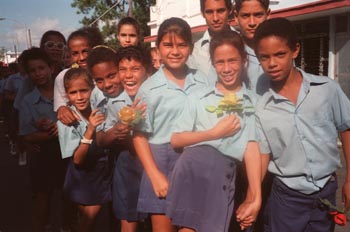
Dan Pulcrano
Some held flowers for the fallen comandante.
The Castro government, though criticized by Fidel's detractors for leaving Che to die in Bolivia, promptly began branding its revolution with the Che logo and erected a huge monument in Santa Clara to his memory. By 6am Friday, the streets of Santa Clara are filled with people heading toward this memorial, as shaved-ice vendors set up their concessions. Flags and portraits of Che hang from balconies and doorways, and Che speeches and songs broadcast from speakers and horns.
Jimo and I reach the fenced-off area beneath the Che statue before 7am, and though we're two hours early, people are already pushing and shoving as in the front rows of a rock show. A large empty area for marching soldiers and military bands separates the crowd from the viewing stand, where rows of chairs and a podium await government officials and other dignitaries. By 8:30am the chairs are half-full, the sun is hot and a drumbeat comes over the sound system. Right about 9am, the crowd breaks into spontaneous applause, and I notice a figure in green fatigues standing tall near the podium. Fidel Castro clasps his hands together as guitar music kicks in. The arena-sized crowd sings along to the familiar cancion about Comandante Che Guevara and the battle of Santa Clara, as arms and flags wave slowly overhead and tears stream down cheeks.
The small, flag-draped casket we had seen lying in state during our swing through Santa Clara on Wednesday now rests atop a flower-strewn jeep trailer between the crowd and the reviewing stand. A schoolgirl in a berry-colored skirt and white blouse reads a theatrical pledge to Che. "My friend, my companion, my model, my light, my star," she screams. Then well-known Cuban songwriter Silvio Rodriguez performs a song on his guitar. After the proper warm-up, Castro advances toward the podium, and the crowd chants "Fidel! Fidel!" followed by rapidly accelerating clapping.
He starts his 16-minute speech (mercifully, it was too hot for a seven-hour one) in a quivering, elderly voice that turns stronger as the oratory slides into its cadence and groove. Punching the air with his forefinger, he blasts imperialistas and oportunistas, discrimination against Indians, women and immigrants and mentions everything from the sexual exploitation of children to nuclear weapons in his eulogy. He vows "we will keep fighting for a better world" and ends with Che's ringing call of hasta victoria siempre--until victory always. A 21-gun salute follows.
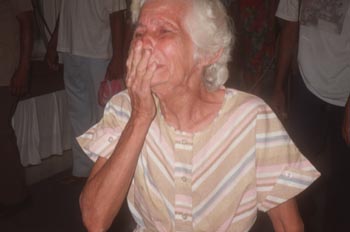
Dan Pulcrano
A woman is overcome with grief upon viewing the wooden box containing Che's bones.
This charismatic display of political theater has no equal here, and to see Castro's oratory live explains four decades of failed U.S. policy. Measures to take Castro down, such as the Helms-Burton boycott legislation signed by President Clinton, seem only to have made his government stronger and increased its authoritarian tendencies. A brief period of liberalization two years ago appears to have reversed course, and while there are some new religious freedoms and foreign investments, there has been little movement toward free enterprise, press freedom or multi-party democracy. Despite well-documented economic and political problems, Castro remains securely ensconced, likely to be dislodged only by his own mortality.
In contrast, Che's restless spirit was characterized by a constant passion to hit the road. His Kerouac-like diary of his youthful motorcycle jaunts around the South American continent enthuse about "our new horizons, free from the shackles of 'civilization'." How would Che, whose journal chronicled wine, women and "our resolutely bohemian ways," have felt about the formal, meticulously orchestrated state funeral that separated people from their government with a gulf of soldiers clicking heels and raising locked-knee legs?
Everyone is entitled to an individualized version of a mythic martyr. My personal Che, forever 39, would have hopped in the car with Jimo and me for cigars and an all-night drive through the scruffy backroads of Cuba, where we could contemplate the present and the future of two countries that can't seem to talk to one another. And I'd ask him, "Where do we go from here?"
[ Metro | Metroactive Central | Archives ]
![[Metroactive Features]](http://metroactive.com/features/gifs/feat468.gif)